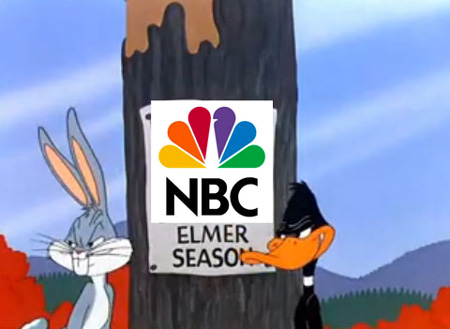{jcomments on}
This is the second part of a multipart analysis on the state of broadcast networks today. Part one can be found here:
I imagine many of you are like me. I missed out on a lot on TV in the late 1990’s and 2000’s. My kids were young. First all our TV had on wasTeletubbies. Then Elmo. Then Powerpuff Girls. Then Spongebob. Now its iCarly. Mom and Dad get two hours of programming a night, and we’ve spent the last few years catching up nightly with shows on the DVR. I never saw Buffy The Vampire Slayer. Angel. Smallville. Battlestar Galatica. How I Met Your Mother. Firefly. Roswell. Flight Of The Conchords. Dexter. Mad Men, etc. I could barely keep up with my must see shows like The West Wing, The X-Files,and name that Star Trek franchise. The CSI procedural (Las Vegas) that I once enjoyed was tossed three years ago because there wasn’t time.
There’s been a solution for my dilemma for a few years now. TV on DVD. Now I can finally catch up on all those old shows I missed that people I know online rave about and it’ll take me less time since there are no commercials. I can breeze through a third of a season in an afternoon. It’s a win for me because I get my second chance and it’s a win for TV studios that produced the show since I’m either purchasing their DVD or renting from Netflix, who did purchase their DVD. Except there’s one problem. If I watch those in that two hour window I have every night or the occasional free weekend day, plus my current must see shows like Supernatural or Chuck, do I have time for any new network shows? Is FlashForward worth a space on my already packed DVR which only gets relieved during times of repeats? V? Fringe? Modern Family? Sadly, the answer is no. Live TV viewing isn’t possible anymore.
My dilemma is one of the reasons broadcast television networks are pleading poverty. There seems to be a common point of blame: the business model. That’s certainly true, but it’s not because they solely rely on advertising for revenue and advertising revenue is down. It’s the result of years of corporate consolidation. Looking back at revenue for the last 25 years, what’s happening is just the latest trend in chasing the next best thing.
The Dirty Little Secret
The dirty little secret is that network viewership has been declining for years. This isn’t the first time that shifts in viewing habits ruined the “antiquated” business model. Back in the 1980’s when VCRs became affordable people were taping their shows and watching later. That led to a decline in ratings across the board. Also, the VCR kick started the home video rental market. Come Friday and Saturday nights, or sometimes less than desirable TV nights, people were stopping at Blockbuster and renting a nice cozy movie or two to enjoy for family viewing, thus shutting out the TV. The exploding popularity of the home computer in the 1980’s didn’t help either, nor the growth of the internet in the 1990s and beyond.
In 1980, more than 90% of the viewing audience were tuned to the big three networks at the time, CBS, NBC, and ABC. In 1993, it was around 53%. By 2005, that number fell to 32%. Somehow though, ad revenue for the broadcast networks kept growing. Total TV ad revenue was roughly in 1999 $25 billion and $30 billion in 2003 where it held steady through 2008. So far ad revenue is almost 22% down during the first three quarters of 2009. How did far less viewers fetch more ad revenue for broadcast networks? Easy, by networks changing the rules.
Once upon a time, CPM (cost per thousands), the measurement used to charge for ads, was based on households. Once VCRs came into the picture and there were multiple viewing choices in households, that measurement changed to number of people watching. Also, advertisers started targeting specific demographic groups, paying a premium for groups that were known to be better spenders or a better target for their brand. The 18-49 age group, especially women, became the golden nugget. Even though shows would have high ratings, if their 18-49 ratings didn’t measure up, it wasn’t considered a desirable brand for advertisers.
So, through the years, networks have built brand based on the premium they could fetch for specific ad demographics. Shows sent to pilot were approved based on what networks perceived to be a good fit for advertising groups and not what might be the more entertaining show. Granted, that sort of thing happened years earlier when advertisers sponsored shows, but the problem really multiplied in the 1990’s and beyond. First, once the Fin-Syn rules were abolished in 1993, more broadcast networks emerged such as FOX, UPN, The WB and even PAX. That diluted the primetime viewing options and a full slate of scripted programming was already becoming way too expensive because of rising production costs.
Enter the increase in reality programming. Network execs loved that option. They were cheap shows to produce and they catered to the younger viewers. While advertisers paid less for running their ads during reality shows than scripted shows, the revenue/cost equation worked out to be very favorable, especially when a hit like American Idol came alongwhere the ad rates could go particularly high. The downside to reality programming happened at the studio end of the media conglomerate. Reality programming does not syndicate well or generate great revenue on DVDs.
Even though there were more networks, scripted programming was decreasing and broadening. For networks like The WB and UPN, their strategy was to do niche programming and go after the lucrative 18-34 age group. That translated into a higher CPM for them, but considering their ratings were lower, the revenue didn’t exactly rival the bigger networks. To counter, the shows they produced were lower budget shows, although many went on to be big syndication and DVD hits.
One downside for Fox, The WB, UPN and PAX was the battle for local affiliates. By offering 10 to 13 hours of primetime choices per week, they had to build a reliable affiliate network that would air their programming without interruption and promote it. These affiliates were independent local stations that usually ran off-net syndication shows during primetime. That meant a lot of less hours available to sell shows into local market syndication. Cable television stations had to pick up the slack, which was growing by leaps and bounds. In 1993, the average family had access to 26 cable channels. By 2009, that number was well over 100 and growing.
Surely that meant much more options for off-net syndication, right? No, not really. Because of the networks decreasing original programming in favor of reality and the smaller networks producing more specialized shows, that meant less desirable programs for syndication for more cable stations. Sure that created a great bidding war for franchises like CSI and Law & Order, but most shows got shut out because of expense. The budgets of many of these cable stations to acquire shows wasn’t there and syndicated shows weren’t drawing what they used to ratings wise, so a full lineup wasn’t worth the expense.
Why weren’t second run syndicated shows a draw anymore? Because of the widespread availability of entire catalogs of TV shows on DVD of course. By 2004 sales of TV shows on DVD exploded and most of the major network shows had their previous seasons available on DVD. Plus, there was the growing need on cable to differentiate programming for those demographic advertising dollars. Buying leftovers from other “branded” networks didn’t fit into that strategy.
Given that cable had the advantage of subscription revenue as well, cable channels started venturing into original programming. Why not beat the networks at their own game? Their strategy was clear. Do shows the networks wouldn’t dare do because they don’t cater to the masses, but do shows that will draw in their niche. Do s
omething original and critically acclaimed for attention since the networks weren’t doing that either. HBO was the first with Sex In The Cityand The Sopranos. Suddenly, original programming wasn’t out of reach for these stations anymore, even basic cable.
So started the vicious cycle. Studios made money on TV by DVD sales to offset shrinking syndication options, partially caused by TV on DVD. That made some shows even less desirable for syndication. Serial programs like Lost don’t do well in syndication because the viewer has to watch every episode to get the plot. However, that’s the type of show that sells very well on DVD. The CSI franchise though makes billions of dollars in second run syndication, but not so much in the DVD market. It’s a little like robbing Peter to pay Paul.
Despite all this confusion, TV studios DID find a way to adapt to the changing environment and still make money. Whether or not shifting revenue between syndication and DVD sales made them more or less money is unclear. Media corporations go to great lengths to hide the detailed figures of what they make from what. TV revenues are often lumped together on balance sheets and income statements. Let’s just say that while revenue has increased throughout the years, so has cost. DVD distribution costs more than syndication distribution.
Sure, the economic downturn can be blamed for the drop in revenue, but those are usually temporary. Not only did advertising revenue fall, but viewers are buying less TV DVD sets now. Thanks to free streaming from online sites like Hulu, many TV shows are now available online. There are so many choices with online viewing and DVR, there’s less time left for DVD and practically nothing for live television.
What are networks doing about their shrinking piece of the pie? Easy, they’re trying to change the rules again. All the major media companies are battling for a new measurement system for ratings. They want DVR and online viewing counted and tacked onto the viewing numbers. Their reasoning is simple; to prove to advertisers that more people are watching their shows than live ratings indicate. They can use that figure to get more advertising dollars from them by selling ads on these multiple platforms. So far advertisers have resisted the idea of multiple viewing platforms and prefer to pay on live ratings and some DVR only. The issue is not much different from the past when CPM shifted from households to number of people.
Let’s remember the dirtiest secret of all. Many of these lucrative, double income stream cable networks are owned by the media companies that also own the big broadcast networks. For example, USA and Syfy is owned by NBC Universal, TNT and TBS is owned by Time Warner, FX and Fox News is owned by Fox and of course the Disney Channel, ESPN, and ABC Family are owned by Disney, the parent company for ABC. So, while broadcast is declining, cable is picking up the slack.
There is one revenue stream that media corporations are heavily relying on now, one that used to be a supplementary source of revenue and is still growing. In the next installment, I’ll go through the thriving business of International Syndication, as well as why online isn’t paying off yet and why a broadcast network going cable isn’t a practical idea – yet.






Hello Alice,
both articles are great and give you a good inside look.
I had a discussion on the cbox with some Americans and Canadians about that whole thing a few weeks back. And I told them that not only the ratings for advertisement are a money maker for a TV show but that they also make a huge deal of money by selling the show to other contries. So I am very interested in reading that next article.
And then I also wonder how the internet ratings should work. Would we abroad suddenly count into it too? Or would it be like CW does it now that you can not watch their shows on their side if you are not in the US. So there are still uncounted sites that will show TV shows and those clicks wouldn’t count then again or would they?
Hope I was able to bring my point across.
Thanks again Alice for all your work.